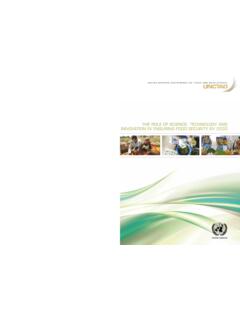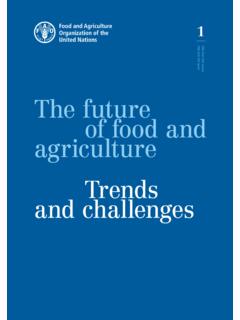Transcription of Human Security: Building Resilience to Climate Threats
1 Human security : Building Resilience to Climate ThreatsOne of the most pressing issues of our time, Climate change threatens the lives and livelihoods of billions of people. Natural disasters, environmental degradation and extreme weather patterns disrupt harvests, deplete fisheries, erode livelihoods and spur infectious diseases. Some effects come on suddenly, as when a typhoon of unprecedented force destroys entire communities. Others unfold over time. Persistent drought, for instance, destroys crops, leaving people without income or food . Demographic trends, migration and rapid urbanization converge with Climate change, raising the stakes for those most vulnerable.
2 Climate change is also a threat multiplier. The loss of land and livelihoods, against a backdrop of persistent poverty, displacement and other insecurities, can trigger a desperate competition for scarce natural resources and fuel social to a changing Climate requires comprehensive, integrated strategies that simultaneously address social, economic and environmental consequences. Human security takes this approach, and UN Member States have overwhelmingly highlighted its importance in acting on Climate change. At the end of 2015, 195 Parties to the UN Framework Convention on Climate Change endorsed the historic Paris Agreement. Signatories pledged to curb emissions to minimize the rise in temperatures, and strengthen capacities to manage Climate risks.
3 The agreement sets the stage for progress in ending poverty, strengthening peace and ensuring a life of dignity and opportunity for all the main tenets of Human People to Protect Themselves and the PlanetEffective responses to Climate change depend on in-depth analysis of how different Threats and insecurities intersect. By placing people at the centre, the Human security approach encourages broad participation that provides detailed insights into varying challenges in communities and regions. This process yields comprehensive information on the levels, trends, connections and distribution of risks and vulnerabilities. Human security programmes can then be oriented around not only improving people s well-being in the short term, but also sustaining gains that are made over the longer term.
4 The Human security approach uses targeted, evidence-based protection and empowerment strategies to mobilize people around adapting to and mitigating the impact of Climate change. It helps strengthen Resilience and protect livelihoods, including through improving disaster-related early warning systems. By supporting community actions, it aims to reduce disaster risks, make sustainable and fair use of environmental resources, and foster peaceful, prosperous the Human security framework, international, national and local actors can better prioritize and coordinate short- and long-term responses to Climate change, and determine where collaboration will produce the most powerful results.
5 As many drivers of Climate change go beyond the response capacity of individuals and communities, this kind of partnership is essential to tempering impacts, reducing root causes of vulnerabilities and sustaining political commitment. Making an Impact: The UN Trust Fund for Human SecurityEstablished in 1999, the UN Trust Fund for Human security (UNTFHS) has funded a number of programmes related to Climate change and environmental disasters, and their links to abject poverty and insecurity. The Human security approach covers social, political, economic and environmental Climate consequences that otherwise undercut community and individual well-being, social cohesion and stability.
6 Programmes have strengthened the capacity of communities to cope with and recover from Climate -related Threats , while simultaneously reducing related food , health and economic insecurities. They build protection through local and national response mechanisms and improved early warning systems, as well as empowerment through greater community participation in identifying and finding solutions to existing and emerging : Empowering people to cope with environmental devastationOne example of a UNTFHS programme has involved the Aral Sea. Once the world s fourth largest lake, it is now one of its worst environmental disasters, having lost most of its water and become a barren desert.
7 This has caused local populations in Uzbekistan s region of Karakalpakstan to suffer from multiple insecurities. Dust storms destroy crops and health, water quality is poor, and food insecurity is widespread due in part to the encroaching salinization of land. Working with poor communities in the region, a Human security programme has increased economic, food , health and environmental security , with benefits reaching nearly 500,000 people. Using a mutually reinforcing protection and empowerment framework, the programme has helped local authorities improve the quality of services and infrastructure, resulting in better access to water and sanitation services, basic health care and energy supplies.
8 Support for local communities to improve their livelihoods has boosted productivity on small farms and increased the production and marketing of local the multidimensional consequences of environmental disasters require comprehensive and well-coordinated solutions, the Human security programme has galvanized engagement by multiple United Nations entities, and capitalized on the expertise of local, national and other international actors. It has worked through community structures known as malhalla to foster local ownership and advance solutions that are sustainable and strongly rooted in :Developing comprehensive strategies to reduce multiple risksThe Pacific island countries and territories are among the places most vulnerable to Climate change.
9 In low-lying Vanuatu, not only are people s livelihoods and dignity under threat, but so is the very existence of their country given rising sea levels. Fertile land and freshwater increasingly suffer from the intrusion of salt water, while a variety of natural disasters, from typhoons to volcanic eruptions, have destroyed homes and lives. A comprehensive approach is therefore needed to build Resilience so that people can cope with these multiple hazards. Geared towards the nearly 40,000 inhabitants of 12 of the country s most vulnerable communities, a UNTFHS programme has helped to develop a series of multisectoral disaster risk reduction strategies. Covering a combination of social, economic and environmental Threats , these strategies take on the interconnected issues of local governance, land planning, income generation, poverty reduction, food security , nutrition, water management and sanitation.
10 To respond precisely and comprehensively to specific local needs, the programme brought together United Nations entities, local and national governments, NGOs, international donors and civil society organizations to identify, map and prioritize Human security Threats . A combination of top-down and bottom up strategies involved training provincial officials to factor disaster risks into policies and budgets, and empowering communities to take local actions to build Resilience . KENYA:Partnerships with local communities boost Resilience in the face of droughtIn the border communities of Turkana, Kenya, recurrent Climate -related droughts have cut livestock production.
















